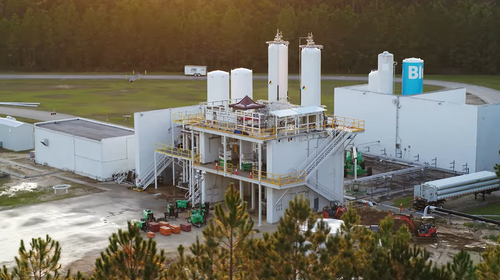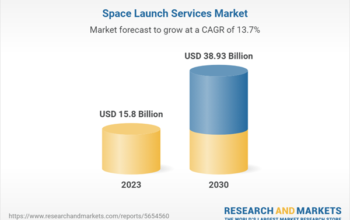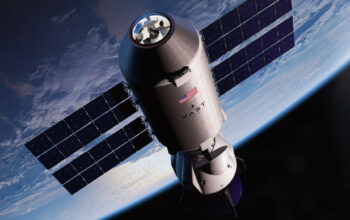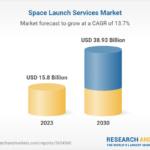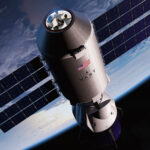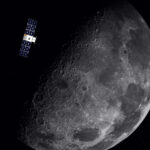Relativity Space recently detailed its plans to operate one of the largest rocket engine test facilities in the United States. Through an agreement with NASA, Relativity is significantly expanding its facilities and infrastructure at NASA's historic Stennis Space Center in Hancock County, Mississippi. The new facilities will support testing of Relativity's entirely 3D printed Aeon R engines for its fully reusable 3D printed rocket, Terran R.
Relativity will utilize over 150 additional acres within the Stennis Test Complex, with testing infrastructure for its Aeon R engines being built from the ground up on previously unutilized land north of the A and E Test Complexes. Relativity has begun ground clearing work for several new engine test stands, a full scale second stage stand, office buildings, and a vehicle hangar.
Source: Relativity Space

New Agreement with NASA Puts Relativity Space on Path to Operate One of America's Largest Rocket Test Facilities
Construction is Underway on New Test Complex at NASA's Stennis Space Center to Support Aeon R Engine Testing and Terran R Stage Testing
Bay St. Louis, Mississippi (October 18, 2022) – Relativity Space, the first company to 3D print rockets and build the largest metal 3D printers in the world, today detailed its plans to operate one of the largest rocket engine test facilities in the United States. Through an agreement with NASA, Relativity is significantly expanding its facilities and infrastructure at NASA's historic Stennis Space Center in Hancock County, Mississippi. The new facilities will support testing of Relativity's entirely 3D printed Aeon R engines for its fully reusable 3D printed rocket, Terran R.
Relativity will utilize over 150 additional acres within the Stennis Test Complex, with testing infrastructure for its Aeon R engines being built from the ground up on previously unutilized land north of the A and E Test Complexes. Relativity has begun ground clearing work for several new engine test stands, a full scale second stage stand, office buildings, and a vehicle hangar. The company is already underway testing Aeon R components across Relativity's E2 test complex, with plans to build the first Aeon R engine and turbopump assembly and begin thrust chamber assembly tests for its Aeon R engines in the coming months at a leased E1 test cell. Full Aeon R engine tests are tracking to occur in late 2023 at Relativity's newly announced facility expansions.
Relativity currently occupies several operational facilities at Stennis, which include four exclusive-use test stands in the E4 area used for Terran 1 stage testing and Aeon 1 engine testing, two exclusive-use stands in the E2 area used for Aeon 1 engine and Aeon R component tests, and one cell on the E1 test stand available through a Reimbursable Space Act Agreement for Aeon R engine tests. Additionally, Relativity has expanded into several buildings that house its rapidly growing team and test control operations. These facilities have enabled more than 2,000 engine tests, multiple successful mission duty cycles, and a fully-integrated stage testing of a 3D printed orbital flight article – which is not only a first for Relativity but for the entire aerospace manufacturing industry.
Relativity's partnership with NASA advances innovation, economic development, and job growth in the Gulf Coast, while also progressing the company's leadership in American aerospace development. Relativity will continue to invest in regional workforce development programs, university and education outreach, and community engagement initiatives.
“We're looking forward to writing some new history at Stennis through an incredibly large new expansion of development and test capabilities. We're honored to partner with NASA and are grateful for their support. We look forward to growing our Stennis-based team, who will be pivotal in our success of meeting many more first-ever milestones as we scale our Terran R program.” – Relativity Space Cofounder and CEO, Tim Ellis
“The access to infrastructure in Mississippi is unparalleled. I look forward to working with NASA as the historic Stennis Space Center continues to evolve to support commercial space test programs and to attract and hire top talent as we build the future of aerospace manufacturing. We know the history of excellence at Stennis and take great pride in being able to repurpose existing infrastructure that has withstood the test of time. But we will also build brand new test stands in a place so central and vital to American aerospace innovation.” – Relativity Space Vice President of Test and Launch, Don Kaderbek
“We welcome the growth of this valued partnership with Relativity Space,” Stennis Space Center Director Dr. Rick Gilbrech said. “NASA is committed to working with commercial companies to help them achieve their space goals, and Stennis is a proven leader in enabling such partnerships. Since their arrival in the spring of 2018, Relativity Space has continued to grow as a respected member of the Stennis federal city. We look forward to their continued development as an aerospace manufacturing and launch company.” – Stennis Space Center Director, Dr. Rick Gilbrech
“This expansion is proof that Mississippi's future as an aerospace hub is bright. I congratulate Relativity Space on their continued growth and their effort to bring quality jobs to our state. American leadership in space starts in Mississippi, and I expect many great things to come.” – U.S. Senator, Roger Wicker (R-Miss.)
“Mississippi's Stennis Space Center precedes its reputation for excellence in rocket engine testing, and Relativity's growing presence will only further that reputation. I look forward to seeing what new aerospace innovations are brought about from this exciting expansion and partnership, as well as what new talent it will attract.”- U.S. Senator, Cindy Hyde-Smith (R-Miss.)
About Terran R
As a two-stage rocket with a 5-meter payload fairing, Terran R will be entirely reusable and capable of launching 20,000kg to low Earth orbit (LEO). Terran R is made possible through the company's proprietary 3D printing process, which utilizes software-driven manufacturing, proprietary, high-performance next generation materials and unique design geometries that are not possible to achieve in traditional manufacturing. Relativity's Stargate printers, the largest in the world, can produce Terran R as well as Terran 1.
Combined with the ability to launch 20X more payload than Terran 1, Terran R provides both government and commercial customers affordable access to space, in LEO and beyond. With satellite technology advancements, demand for bandwidth soaring and satellite constellations representing the largest part of the growing market, Terran R was accelerated to accommodate the growing demand for large constellation launch services, and the company's growing pipeline of commercial interest. As a testament to its commercial viability, Relativity has signed five customer launch contracts for Terran R to date, including a multi-launch agreement with OneWeb and its first commercial mission to Mars with Impulse Space.
About Aeon R and Aeon Vac Engines
Terran R will be outfitted with 3D-printed Aeon R engines capable of 250,000 lb. thrust each, while its upper stage houses one Aeon Vac engine. Aeon R and Aeon Vac are 3D-printed, enhancing mission reliability by reducing part count in engine combustion chambers, igniters, turbopumps, reaction control thrusters, and vehicle pressurization systems. All Aeon engines use propellants of the future, liquid oxygen and liquid natural gas, which are not only the best for rocket propulsion, but also the easiest to eventually make on Mars.
For corrections or follow-up: editor@website
You may like these posts too:
- No related posts.


